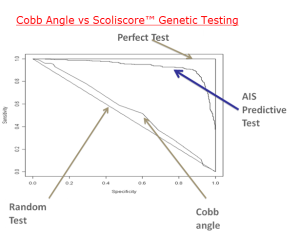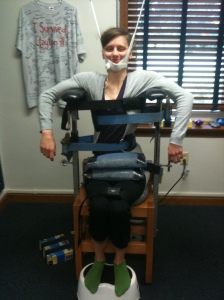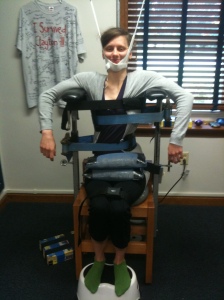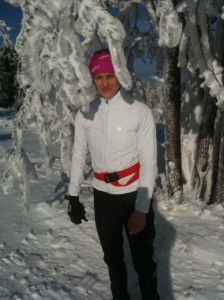The “ScoliPAIN-Progamm” – Scoliosis treatment for adults
4. Interview with Dr. Clayton Stitzel
What is the ScoliPAIN-programm?
The ScoliPAIN program is a less intense 5 day program designed to reduce pain, increase function, and get the patient started on a home rehab program to provide long-term stability
How old are the ScoliPAIN Patients?
There are no actual age requirements for the program, as each case is accepted or declined individually, but ultimately the program is really about helping patients reach their treatment goals for when curve reduction isn’t the top priority.
What is the difference between treating mature patients and adolescent patients? Are there different treating methodes?
The goal in each case is the same, improving biomechanical function of the joints, but there are many different ways of doing it and all can be modified to meet the needs of the patient.
Do the patients continue the programm at home?
They do. In many cases, scoliosis is a life long journey, thus a rehab program has to reflect that as well.
Do the ScoliPAIN patients come for a reevaluation?
No, they don’t. Since the primary treatment goal is not curve reduction, a x-ray re-evaluation is not necessary.
Do ScoliPAIN patients reduce their curves?
I’m sure many do, but often to insignificant amounts do to the structural limitations of their case and the design of the program.
Are there any long term studies?
The program is relatively new, so no long term data is available at this time.
Lern more: http://www.treatingscoliosis.com/scoliosis-pain.html
German version: https://meinskoliosebootcamp.wordpress.com/2015/01/16/scolipain-die-skoliosebehandlung-fur-erwachsenen/
At least we had a little bit of snow this year!
ScoliScore? Neurotransmitter?
The third Interview with Dr. Clayton Stitzel about ScoliScore Testing and Neurotransmitter
ScoliScore
What is ScoliScore Testing? Does every patient get tested?
Stitzel: ScoliScore is a saliva test for genetic pre-disposition that identifies 53 markers that are associated with severe scoliosis progression. “Test-able” patients have to be between the ages of 9-14, non-Asian (unique genetic markers for scoliosis), and have a curve between 10-25°. They can be male or female and about 15% of the “ScoliScore” (0-200) is based off the genetic markers and 15% is based off other measures like age, cobb angle, ect.
How does the testresults influence the treatment of the patient?
Stitzel: I can’t speak for how it influences the treatment protocols for other doctors, but we find that it allows us to “gage” the most appropriate level of treatment invasiveness for the patient prior to the curve progressing. For example, a patient with a very high ScoliScore (<180 out of 200) may elected to have a minimally invasive, non-fusion procedure like vertebral body stapling or tethering done in anticipation of a major growth spurt. Likewise, a patient with a low ScoliScore (>50) may choose to only engage in a rehab based program like the Scoliosis BootCamp program to minimize curve progression risk. We have even developed an alternate treatment model flow chart based off the patient’s ScoliScore, rather than Cobb angle, witch is much more accurate. I have provided images for of both the ScoliScore directed treatment model and the Cobb angle vs ScoliScore curve prediction graph.


Neurotransmitter
One part of your treatment is “neurotransmitter-rebalancing”.
What are neurotransmitter? Neurotransmitters are the chemicals in your brain that allow your brain and body to communicate with each other. Serotonin, Melatonin, and Norepinephrine are some of the more common ones people have heard of.
How do neurotransmitter imbalances relate to scoliosis? How does “neurotransmitter-rebalancing” work?
Our research has uncovered a common pattern of neurotransmitter imbalance in scoliosis patients that seems to revolve around the Serotonin-Melatonin conversion pathway, which is especially significant given the compelling research linking Melatonin to the development of idiopathic scoliosis in adolescent patients.
Re-balancing neurotransmitters is a very safe and simple process involving mostly specific amino acid supplements. The trick is doing the testing to identify the imbalances and making the appropriate recommendations.
What kind of supplements do the patients take?
Generally amino acids, but sometimes specific enzymes, minerals, or vitamins may be required to increase absorption or active a specific conversion pathway.
How long do patients need to take the supplements?
Most patients will need to take them for 4-6 months before re-testing and further recommendations can be made at that time based off the new testing information.
Do adult patients also have unbalanced neurotransmitters? Would you recommend “neurotransmitter-testing” and an supplementation for adults,too?
I’m sure they do have imbalances. We haven’t done enough work with the testing and treatment to know how much benefit it may have for adult patients, but there is certainly no downside to having your scoliosis specific neurotransmitters in balance, so I don’t see the harm.
Are there any studies about the correlation of Neurotransmitter imbalances and scoliosis?
ScoliSMART Clinics are really the ones to bring this new information and technology into the field of scoliosis treatment, so the published research is limited, but we do have a peer reviewed study comparing to groups who went through treatment (one with re-balancing, one without) programs in one of our offices that should be published literally any day now. Also, Dr. Mark Morningstar has presented his findings at the 2013 Chicago SOSORT conference and even done some lectures that are available on YouTube http://youtu.be/9EJWKHi0_80
German version: http://meinskoliosebootcamp.wordpress.com/2014/12/07/scoliscore-test-neurotransmitter/
Interview “Scoliosis Activity Suit™”
ScoliSmart and BootCamp interview
with Dr. Clayton Stitzel, Chiropractor at the ScoliSmart Clinc Pennsylvania USA
What does scoliosis mean?
Traditionally scoliosis has been defined simply as a curvature of the spine, but in recent times we are subdividing the condition into various kinds of scoliosis with Adolsecent Idiopathic Scoliosis (AIS) being the most common. We now now AIS has a genetic predispositon and almost certainly a neuro-hormonal cause that creates the spinal curve as the primary symptom.

What is the concept of ScoliSmart?
ScoliSMART is an effort to create a more comprehensive program that treats the whole scoliosis condition, not just the curve. Our triad of care includes dynamic rehab with the Scoliosis Activity Suit, neurotransmitter re-balancing, and static rehab with the torso trainer.
What is the difference to other non-surgical treatments like Schroth?
Schroth was the forerunner of all scoliosis exercise approaches, but relies on voluntary movement exercies, which is a bit out dated since we know spinal alignment is controlled by automatic postural control centers in the brain. Our approach is re-training those automatic postural control centers with subconscious rehab techniques.
What´s the Bootcamp and how long does it take?
Scoliosis BootCamp is our 10 program for patients with spinal curves larger than 25 degrees.
Is it necessary to continue the treatment all life long?
In most cases it is not necessary. Most patients can dyscontinue the rehab once they are done growing, although patients with curves larger than 30° do have an increase risk of adulthood progression and may benefit from continued rehab on a less frequent basis.
What happens after the Bootcamp? Is there a homeprogramm and a follow up?
We provide each patient with a personalized home rehab program and recommend re-evaluation 4-6 months later.
Do the results of your patients last?
We are in the process of publishing several long-term results studies that suggest the results do last, but each scoliosis is it’s own to a certain degree (pun intended)
Is it necessary to treat small curves?
The one thing all large scoliosis curves have in common is that they started out as small curve first.
Is the Bootcamp treatment also suitable for adults?
Yes, we have successfully treated many adults with the Scoliosis BootCamp program.
German version: http://meinskoliosebootcamp.wordpress.com/?p=170&preview=true
Mein Aufenthalt im “Scoliosis Bootcamp” Pennsylvania

Ende Juni hatte ich die Ehre als erste Deutsche an einem 10-tägigien “Scoliosis Bootcamp” am Lancaster Spinal Health Center in Lititz/Pennsylvania teilzunehmen.
Als ich im Internet vor einigen Monaten von dieser chiropraktischen Therapie erfuhr, überzeugte mich der Therapieansatz sofort. Anders als die mir bisher bekannten Behandlungsmethoden für Skoliose, setzt die sogenannte “CLEAR-Methode” näher an der Ursache der dreidimensionalen Wirbelsäulenverkrümmung an.

Meine Behandlungsziele waren, zunächst eine Lockerung des Weichteilgewebes der Wirbelsäule (Muskulatur, Bänder, Sehen) zu erreichen, um anschließend die Wirbelsäulengelenke in die richtige Position bringen zu können. Abschließend wird versucht durch bestimmte Rehabilitationsübungen dem Gehirn die neu Körperposition zu vermitteln.
Die Atmosphäre in der kleinen Praxis war sehr positiv und freundschaftlich. Was auch nicht verwundert, denn die guten Resultate, mit denen die Patienten nach Hause gehen, sprechen für sich. Vorwiegend waren jugendliche Mädchen in Behandlung, sie reagieren schnell auf die Therapie und erzielen schon innerhalb der 10 Tagen “Scoliosis Bootcamp” erstaunliche Ergebnisse.
Obwohl ich erwachsen bin, kann auch ich mich über eine Gradzahlverbesserung freuen. Mein Brustbogen verbesserte sich von 57 ° auf 48° und mein Lendenbogen wurde von 28° auf 22°. Durch die genauen Messungen an den Röntgenbildern die weit über den geläufigen Cobb. Winkel hinaus reichen erfuhr ich ebenso etwas über meine Halswirbelsäule und mein Becken. Auch mein Halsbogen verbesserte sich und mein Beckenposition ist nach der Behandlung nahezu normal.
Jetzt heißt es, dran bleiben!!! Seit meinem Aufenthalt in der USA bringe ich täglich mindestens 1 h für meine Rehabilitationsübungen auf und arbeite zusätzlich viel an meiner Beweglichkeit.
In 10 Tagen am Lancaster Spinal Health Center habe ich viel über Skoliose gelernt, von der neurologischen Ursache bis hin zu biochemischen Prozessen die möglicherweise zur Entstehung der Skoliose beitragen. Das Team aus US-Amerikanischen Chiropraktikern kommt der Ursache von Skoliose immer näher und dementsprechend setzten Sie auch Ihre Behandlung daran an.
Meiner Meinung nach gibt es derzeit keine fortschrittlichere Therapie. Ich kann sie nur jedem empfehlen und hoffe, dass sich auch in Deutschland in Sachen Skoliosebehandlung bald etwas ändern wird.
Für Fragen/Infos stehe ich jederzeit gerne zu Verfügung.
Weitere Informationen findet Ihr auf:
http://www.treatingscoliosis.com/https://www.facebook.com/TreatingScoliosis?hc_location=stream
First German at “Scoliosis Bootcamp”
I spent the last two weeks in the USA participating at a ten day “Scoliosis Bootcamp” at Lancaster Spinal Health in Lititz. It was the first time I learned something new about scoliosis. I got to know a holistic tri-dimensional chiropractic therapy which gets closer the cause of scoliosis than any other treatment I know. Its concept seems evident and the idea convinced me the first time I read about it. The goals of the 10-day treatment were reducing the soft tissue resistance, repositioning the spine and reprogramm the brain muscle control to reach a new straighter position.

At Lancaster Spinal Health I felt comfortable from the beginning. The atmosphere at the treatment office was positive and very pleasant. That´s no surprise because every patient I meet had better results after scoliosis bootcamp.
Despite I am an adult my results are good, too. When I started at Lancaster Spinal Health my curves were 57° thoracic and 28° lumbar. After two weeks my scoliosis improved to 48° thoracic/22° lumbar. The treatment also helped me to reduce my cervical curve and my pelvic position is now pretty normal.

I continue the treatment at home. It doesn´t take much time and the main thing is it really works.
I would definitively recommend this treatment!!!
Thanks to Dr. Stitzle and his Team
Learn more about it:
http://www.treatingscoliosis.com/








